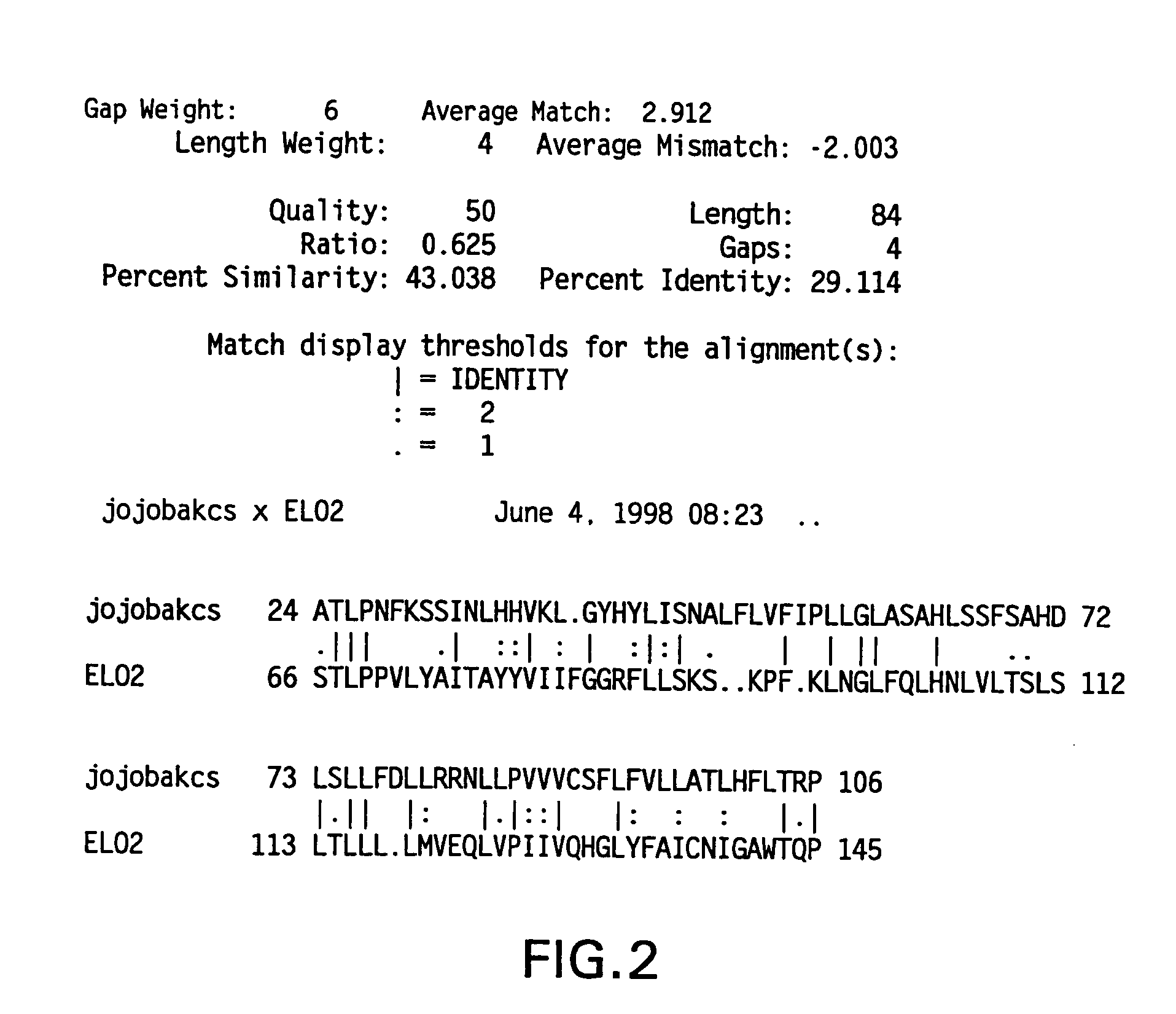Elongase genes and uses thereof
a technology of elongase genes and genes, applied in the field of elongase genes, can solve the problems of cell death, mismatching between bases, and substrate-specific steps but also the rate-limiting steps
- Summary
- Abstract
- Description
- Claims
- Application Information
AI Technical Summary
Benefits of technology
Problems solved by technology
Method used
Image
Examples
example ii
Cloning of a Full-length Elongase-like cDNA from M. Alpina
[0314] The .beta.-ketoacyl-coenzyme A synthase (KCS) from jojoba and the Saccharomyces cerevisiae elongase (ELO2) were aligned to determine an area of amino acid homology (see FIG. 2). The codon bias was applied to the area of sequence corresponding to the homologous amino acids between the two elongases, and primers were designed based on this biased sequence (see FIG. 3). The cDNA was excised from the M11 M. alpina cDNA library (Knutzon et al., J. Biol. Chem. 273:29360-29366 (1998)), which contains approximately 6.times.10.sup.5 clones with an average insert size of 1.1 Kb. The excised cDNA was amplified with internal primer RO339 (5'-TTG GAG AGG AGG AAG CGA CCA CCG AAG ATG ATG-3') and a vector forward primer RO317 (5'-CAC ACA GGA AAC AGC TAT GAC CAT GAT TAC G-3'). Polymerase Chain Reaction (PCR) was carried out in a 100 .mu.l volume containing: 300 ng of excised M. alpina cDNA library, 50 pmole each primer, 10 .mu.l of 10....
example iii
Expression of M. alpina Elongase cDNA in Baker's Yeast
[0317] The constructs pRAE-5, and pRAE-6 we re transformed into S. cerevisiae 334 (Hoveland et al., Gene 83:57-64 (1989)) and screened for elongase activity. The plasmid pCGN7875 (Calgene LLC, Davis, Calif.) containing jojoba KCS gene in pYES2 vector (Invitrogen Corp., Carlsbad, Calif.) was used as a positive control. The substrate used to detect elongase activity in M. alpina elongase (MAELO) was GLA and that in jojoba KCS was oleic acid (OA). The negative control strain was S. cerevisiae 334 containing pYX242 vector. The cultures were grown for 40-48 hours at 25.degree. C., in selective media (Ausubel et al., Short Protocols in Molecular Biology, Ch. 13, p. 3-5 (1992)), in the presence of a particular substrate. The expression of the jojoba KCS gene cloned in pYES2 was under the control of GAL1 promoter, while the promoter in pYX242 is TP1, which is constitutive. Hence, the 334(pCGN7875) and 334(pYES2) cultures were induced wit...
example iv
A Comparison of the Expression of M. alpina Elongase cDNA MAELO and S. Cerevisiae Elongase ELO2 in Baker's Yeast
[0321] The ELO2 gene encoding for the yeast elongase was cloned from an S. cerevisiae genomic library (Origene, Rockville, Md.) using the primers RO514 (5'-GGC TAT GGA TCC ATG AAT TCA CTC GTT ACT CAA TAT G-3') and RO515 (5'-CCT GCC AAG CTT TTA CCT TTT TCT TCT GTG TTG AG-3') incorporating the restriction sites (underlined) BamHI and HindIII (respectively). The ELO2 gene was cloned into the vector pYX242 at the BamHI and HindIII sites, designated pRELO, transformed into the S. cerevisiae host 334 (Hoveland et al., supra) and screened for PUFA elongase activity. The vector plasmid was used as a negative control and 334(pRAE-5) was grown to compare the PUFA elongase activity. The cultures were grown as previously described with no galactose in the media and 25 .mu.M GLA added as a substrate. FIG. 12 shows that amount of 20:3n-6 or DGLA produced (elongated from 18:3n-6 or GLA) ...
PUM
| Property | Measurement | Unit |
|---|---|---|
| weight % | aaaaa | aaaaa |
| weight percent | aaaaa | aaaaa |
| weight percent | aaaaa | aaaaa |
Abstract
Description
Claims
Application Information
 Login to View More
Login to View More - R&D
- Intellectual Property
- Life Sciences
- Materials
- Tech Scout
- Unparalleled Data Quality
- Higher Quality Content
- 60% Fewer Hallucinations
Browse by: Latest US Patents, China's latest patents, Technical Efficacy Thesaurus, Application Domain, Technology Topic, Popular Technical Reports.
© 2025 PatSnap. All rights reserved.Legal|Privacy policy|Modern Slavery Act Transparency Statement|Sitemap|About US| Contact US: help@patsnap.com



